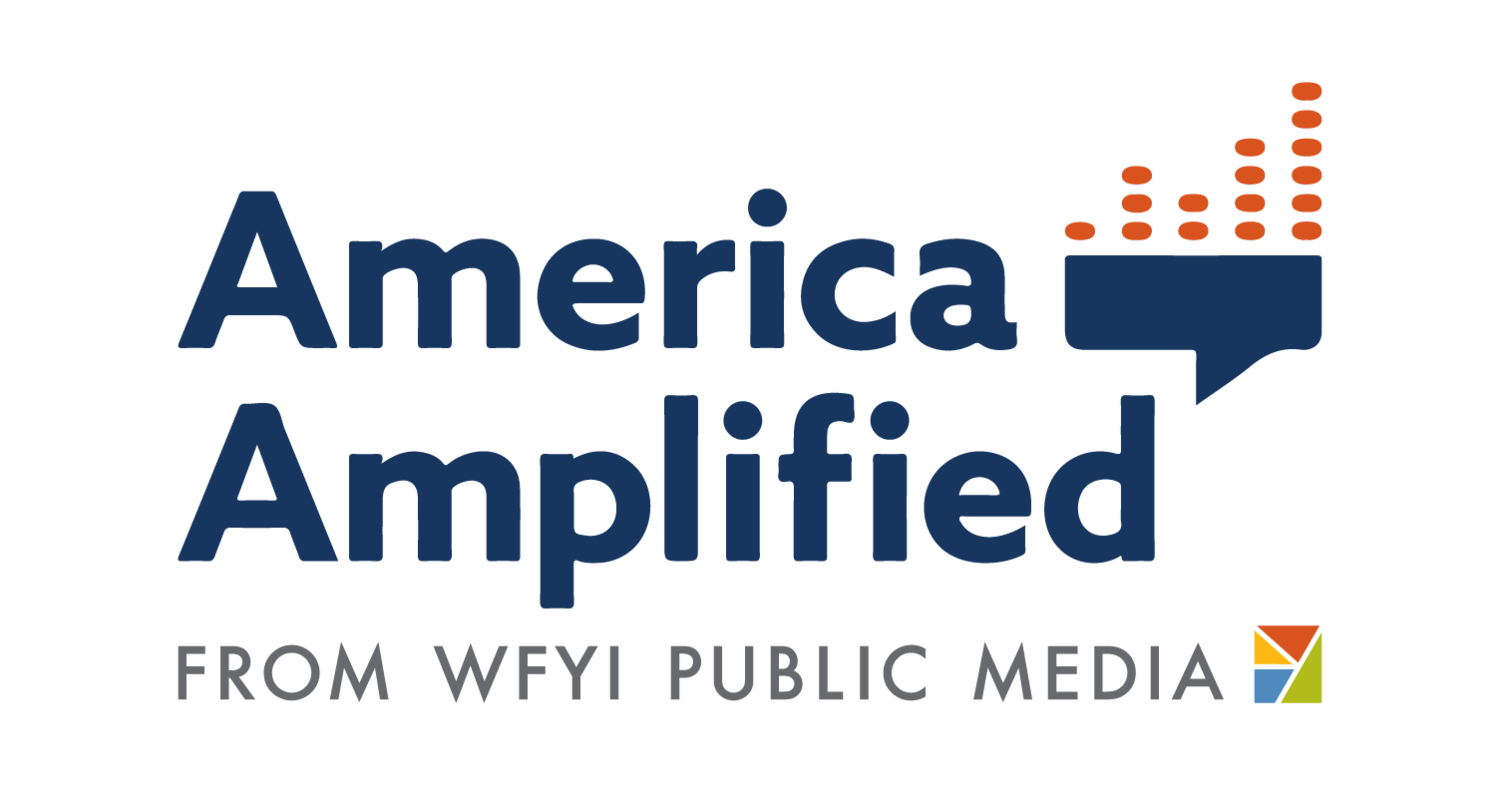How I prioritized listening, empathy and diversity in producing America Amplified’s talk show
The talk show production team batted many ideas around during our meetings. Top row, from left: Andrea Tudhope, Kathy Lu, Grace Walker, Mayowa Aina. Center row, from left: John Dankosky, Rose Scott, Daniela Luna, Matthew Long-Middleton. Bottom row, from left: Jennifer Tufts, Alisa Barba, Ron Jones.
As a former daily local talk show producer, I understand how stressful it can be to imagine switching things up in your daily production routine. But I promise you, it’s worth it.
Having a platform like ours is a privilege, and we have a responsibility to use that platform wisely and conscientiously, and that means challenging our norms and trying new ways to truly put the community first. We did that for our 6-week national talk show around the 2020 election.
Our show was a collaborative effort drawing on resources from stations across the country. We had no pre-existing framework for the show, so I was able to dream big and try out several strategies. As someone who’s worked on a smaller scale, though, I know that a lot of what we accomplished at the national level can be replicated at the local level.
Here’s how I did it.
‘Listen first’ is my daily mantra
From the very start, our show was centered around community. Our team held a dozen virtual listening sessions with participants from across the country and, after each session, we would digest what we heard — reflecting on themes that arose, or thoughts that stood out to us. That’s how we landed on topics for our shows, like ‘What divides us?’ and ‘Who has access to the American Dream?’ The listening sessions also provided us with several guest possibilities for our shows.
Even the structure and framework was derived from the insights of the community members we met.
For instance, we heard a consistent call for “good news” in media coverage. So I decided we would end each show with a short audio postcard, highlighting how one community was coming together in the face of crisis, or how a local artist was finding solace and healing for their community in their craft. Here’s one audio postcard from reporter Sydney Boles, highlighting a storytelling festival in Pound, Virginia.
Though we started out with a topic for each show gleaned from our listening sessions, we still kept an open mind to let our guests be our guides each week. Listening first is a mentality you can apply to any stage of producing a show.
I gave the guests the driver’s seat
A lot of us pitch and pursue topics for our talk shows based on what we think are hot-button issues right now. But ... we’re not all-knowing, and even journalists live in bubbles. That’s why I think it’s so important to get out into the community, host a listening session, even call up new folks you haven’t talked to before with open-ended questions like, ‘What's going on in your neck of the woods lately?’
Rather than coming up with a topic internally — on our most likely homogenous staff, let’s be real — and then reaching out to people to fill a specific perspective, reverse that process: Invite community members to the table and let them drive.
For our fall show, we approached our pre-interviews with simple and open-ended questions: What are the main issues facing your community right now? How are you overcoming challenges? What are your hopes for the future for your community?
We then shared what we heard from our sources in production meetings, and from there, we honed in on the focus for our show. Our third episode, in which we spent time discussing who and what is usually missing from national media coverage and presidential debates, is a great example of how this can work.
It’s a subtle shift, but an impactful one. You can hear the difference not only in the way the show plays out, but also in the way the guests speak and share their perspectives. Our guests knew that this show was for them.
Hosting plays a big role in this shift. Rose Scott, our stellar host from WABE in Atlanta, skillfully facilitated this by keeping her questions short, and placing emphasis on letting guests respond to each other directly, transitioning between guests with a simple — “Guest A, you heard what Guest B said, what are your thoughts?”
The impact of empowering your sources and guests cannot be understated. And listeners notice!
Here’s an email we received from a listener in Louisville:
“I heard your show kinda by chance this evening. OMG! Your idea of having people of different opinions actually speaking to each other without yelling is like salve to my soul. BRAVO! BRAVO! BRAVO!”
And another, from a listener in New York:
“For months all the public voices I have heard were rants or one sided comments from all other media outlets … [Your] show let me be connected, even when I did not agree, with all those speaking on all sides of the political spectrum because they shared and explained and were to me fair and honest. We all have different backgrounds and can learn something from each other.”
Lived experience is expertise, and I practice journalism accordingly
With our show we pivoted from the traditional experts… policy makers, politicians, public officials… to make way for community members, experts in their own communities, experiences and personal lives.
I know there’s a need to hear from the public officials, and to hold them accountable. When I have to book a traditional “expert,” I like to prioritize finding folks who both work and live that expertise. For example, in our pre-election show we decided to spend some of the hour exploring and unraveling voting blocs — like the so-called “Latino vote.” To kick off that discussion, we booked Danielle Clealand, a professor in Mexican American and Latino studies, as well as African and African diaspora studies. Danielle is also Afro-Latina herself. All of this made her a wonderful guest who could share nuances and insight from a personal and professional level.
Another thing: the traditional experts we tend to give a platform to are white men. Do yourselves and all of us a favor, and break that mold. Which leads me to…
I make diversity a priority, not just a hollow buzzword
Of course it will take extra time and effort to diversify your source pool. Do it anyway! A lot of us use the word diversity — in our mission statements, for example — but fail to truly commit to it.
We made a commitment from the outset to prioritize diversity in race, ethnicity, gender, political affiliation, sexuality, class, etc. in every show. That meant including in discussions and in show notes the identifiers folks shared with us. We also tracked the diversity in a spreadsheet, so we could see our gaps and correct course along the way.
This is an ongoing process that should be refined as you go along. There are definitely things I think we could have done better. Always! For example, we could have set actual percentage goals for representation.
But we stayed true to our priority throughout, and you can see that in the demographic breakdown. About 45% of the sources in our show who identified as white were featured through our pre-produced elements — meaning we typically heard from them in 10-second clips. Meanwhile sources who identified as white made up a minority of our panel guests at 19%. People who identify as Black constituted the majority of our panel guests at 30%. Altogether, BIPOC — which included folks who identify as Ahtna Athabascan, Navajo, Ojibwe, Zuni, Tohono O'odham, Black, Guatemalan, Afghan American, Korean American, Puerto Rican and Filipina, just to name a few — made up 81% of our panel guests, and 55% of our sources for pre-produced elements.
Typically, in terms of this breakdown between guests and clips in talk shows, the opposite is true. Sources invited to the table tend to be white, while sources featured in clips tend to be POC.
By continually voicing this as a priority every step of the way, we flipped that script.
For me, empathy and humanity are at the heart of the work
In our first listening session last fall, my colleagues facilitated a breakout room conversation between Meadow Kouffeld, a conservative white woman from Minnesota, and Jayme Beasley, a liberal Black woman from Georgia. It was a powerful, emotional conversation about race, one that came up a lot in our team discussions afterward.
I kept in touch with both women over the course of our show. In one phone call I had with Meadow just before the election, I learned that her experience in our session had been eye-opening, and had, along with other life experiences of late, called her to question her political views and who she would vote for.
I decided to call both women after Election Day to invite them into another one-on-one conversation. They both agreed, and we had an hour-long discussion — another doozy. Meadow said she reluctantly went for Trump. She was nervous to talk with Jayme about it. It was a tense but honest and respectful discussion — one I was able to edit down into a short feature for our show. It made for a truly innovative and riveting segment.
There are countless benefits to follow-up — developing meaningful, long-term source relationships will lead you to a reservoir of guest possibilities and show ideas that will keep giving. Throw away your extractive practices, and keep in touch with people. If they had a bad experience, dig in and work through it. It’s a long game, but it’s worth it.



